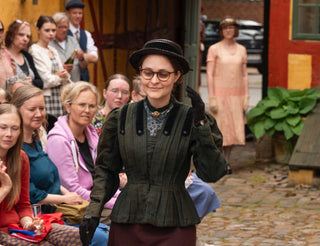How did men and women dressed in the beginning of the 1900s and how did the World War affect the style? Dive into the early 1900s fashion with us.
Edwardian era and art nouveau
The 1900s and 1910s are often referred to as the Edwardian era after British King Edward III, or as the Art Nouveau period, following French influence. The period saw significant changes in fashion and clothing from the earlier Victorian era, partly due to World War I (1914-1917), which impacted society and fashion.
Browse through our collection of Edwardian shoes and boots along with the other 1900s to 1920s shoes.
A classic edwardian outfit, with nipped waist, long skirt, and a parasol to shade from the sun. On her feet is our Edwardian inspired boots, the Victoria boots, in black. From my historical fashion show back in May. Photo: Tami Meijburg
From the Edwardian S-Curve to the Fluid Empire Waist
In the 1900s and 1910s women began to move into traditionally male domains, gaining the right to vote, attending universities, and during World War I, taking over men’s jobs in factories. Therefore there was a need of women’s clothing becoming more practical. Simpler cuts, shorter skirts that often reached mid-calf for easier movement, and looser dresses that placed less emphasis on an hourglass figure were some of the changes in women's fashion.
The iconic Edwardian S-curve silhouette, shaped by a corset pushing the chest forward and creating a wasp waist, was popular at the beginning of the century but started to decline in the 1910s. Empire-waist dresses (with a high waist just below the bust) became popular, featuring soft, flowing skirts that highlighted a more fluid silhouette. Hats were large and elaborate, often adorned with feathers, flowers, or ribbons. Gloves, parasols, and jewelry were important accessories for women across various social classes.
1900s working class women's fashion
In the early 1900s, working-class fashion was shaped by practicality, durability, and affordability, as the majority of the working population needed clothing that could withstand long hours of physical labor. Clothing for both men and women was functional, often made from sturdy fabrics like cotton, wool, and denim.
Womens clothing was practical, with dresses made from durable cotton or wool, often featuring high collars and long sleeves. Skirts were long and full, and sometimes necessarily a bit shorter for women in the working field, to make them more practical while working in factories or on the farm. Aprons were a key part of women's wardrobes, worn over dresses to protect their clothing. Sturdy shoes or boots were worn for work, while simpler hats or headscarves were common for everyday wear.
1900s upper class women's fashion
As previously stated the "S" silhouette was the defining look, with corseted waists and full, voluminous skirts supported by petticoats. Bodices were often adorned with lace, embroidery, and delicate fabrics like silk and satin. High-necked blouses and long sleeves were common, reflecting the modest ideals of the time. For formal events, women wore evening gowns made from luxurious materials like velvet, silk, and satin, often embellished with beads and sequins. Accessories included large hats with feathers and flowers, gloves, and jewelry such as pearls and diamonds.

An example of a late 1910s-early 1920s outfit. Note the looser silhouette and the simple cut. From my historical fashion show back i May. Photo: Tami Meijburg
French Heels to Practical Mary Janes and Oxfords
Women’s Edwardian shoes and boots were often made of leather. The most popular heel of the time was the characteristic curved "French heel." A lower block heel was also common on both boots and shoes and was more practical. In addition to high lace-up or buttoned boots, Mary Jane and Oxford shoes also started to gain popularity in the late 1910s.

The Ruth boots, a classic Edwardian style everyday boot with lace up and a low practical heel.
Men’s Fashion in the 1900s
Men’s fashion in the 1900s and 1910s did not change as dramatically as women’s, though some shifts occurred due to social and political developments. Men typically wore three-piece suits consisting of trousers, a jacket, and a vest. The vest had a high cut, and the suits had a slim fit. Trousers were high-waisted and narrow at the ankles. After the war broke out, men’s fashion was influenced by military styles, with more structured cuts, simple colors (like khaki), and functional garments such as belted coats and trench coats being a very direct fashion influence of the war.
1900s working class mens fashion
Mens workwear typically consisted of trousers or overalls, paired with simple shirts or vests. Many men wore heavy boots or shoes suitable for factory work, construction, or manual labor. Flat caps, worn for both work and leisure, were a common accessory, along with waistcoats or jackets. During the winter, heavier coats made from wool or tweed were essential for warmth. Mens working class shirts commonly featured replaceable collars and cuffs. This design allowed only these parts—most prone to getting dirty—to be washed, sparing the rest of the shirt. Frequent washing was tough on fabric and could cause wear and tear, so minimizing full washes helped preserve the garment. The shirts, collar and cuffs often came in thinly striped patterns, typically white with blue, brown, or green stripes. These patterns helped hide stains better than plain white shirts, further reducing the need for frequent washing.
1900s upper class mens fashion
For men in the upper class, fashion in the 1900s was marked by formal suits, often consisting of a frock coat, waistcoat, and trousers. The morning coat and tailcoat were popular for daytime and evening wear, respectively, and were worn with top hats for formal occasions. Shirts with stiff collars and cravats or bow ties completed the look, and were often white, symbolizing their wealth - they could afford to have their white shirts washed often, and to buy new ones when the old ones tore apart. Men’s footwear included polished leather shoes, and pocket watches or cufflinks were common accessories.
 American fashion plate of upper class menswear from 1896. Notice the slim, long silhouette of the shoes. Source: Metropolitan Museum of Art
American fashion plate of upper class menswear from 1896. Notice the slim, long silhouette of the shoes. Source: Metropolitan Museum of Art
Edwardian mens shoes
Men’s Edwardian shoes matched the sleek silhouette of the time. Shoes and boots were made of leather, with simple yet elegant details, and often featured pointed toes. They were fastened with laces or buttons and had snug-fitting shafts. Heavy leather boots in black or brown were common for working class people.

William is our Edwardian inspired menswear shoe, with the classic pointed toe and fastened with lace.
Curious about what happened next in 20th-century fashion? Check out our blog post on the iconic Gatsby era—the 1920s—right here: 1920’s fashion - Learn about the fashion in the roaring 20’s
Sources:
- Shoes - An Illustrated Story by Rebecca Shawcross
- Tidens Mode by Anne-Grete Steckhahn
- Vintage Fashion - Collecting and wearing designer classics by Emma Baxter-Wright, Karen Clarkson, Sarah Kennedy, and Kate Mulvey



